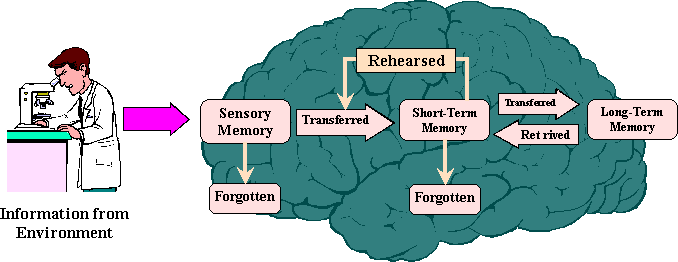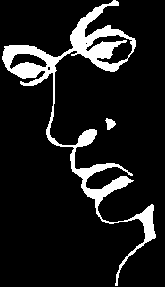Learning and Memory
In cognitive psychology, there is one memory system, but it is normally divided into three functions for storage (Anderson, 2000): sensory, short-term (often called working), and long-term (often called permanent).- Sensory Memory: The sensory memory retains an exact copy of what is seen or heard (visual and auditory). It only lasts for a few seconds, while some theorize it last only 300 milliseconds. It has unlimited capacity.
- Short-Term Memory (STM) - Selective attention determines what information moves from sensory memory to short-term memory. STM is most often stored as sounds, especially in recalling words, but may be stored as images. It works basically the same as a computer's RAM (Random Access Memory) in that it provides a working space for short computations and then transfers it to other parts of the memory system or discards it. It is thought to be about seven bits in length, that is, we normally remember seven items. STM is vulnerable to interruption or interference.
- Long-Term Memory - This is relatively permanent storage. Information is stored on the basis of meaning and importance.
| Donald Hebb (1968) argued that it was doubtful that a chemical process could occur fast enough to accommodate immediate memory, yet remain stable enough to accommodate permanent memory. Hence, the present theory of three storage areas. |
Miller's Magic Number
George Miller's classic 1956 study found that the amount of information that can be remembered in one exposure is between five and nine items, depending on the information.Applying a range of +2 or -2, the number 7 became known as Miller's Magic Number, the number of items which can be held in Short-Term Memory at any one time.
Miller himself stated that his magic number was for items with one aspect as his work is based on subjects listening to a number of auditory tones that varied only in pitch. Each tone was presented separately, and the subject was asked to identify each tone relative to the others he or she had already heard, by assigning it a number. After about five or six tones, subjects began to get confused, and their capacity for making further tone judgments broke down.
He found this to be true of a number of other tasks. But if more aspects are included, then we can remember more, depending upon our familiarity and the complexity of the subject (in Miller's research, there was only one aspect — the tone). For example, we can remember way more human faces as there are a number of aspects, such as hair color, hair style, shape of face, facial hair, etc.
We remember phone numbers by their aspects of 2 or more groupings. We don't really remember seven numbers. We remember the first group of three and then the other grouping of four numbers. If it is long distance, then we add an area code. So we actually remember 10 numbers by breaking it into groups of three. Social Security numbers work on the same principle — xxx-xx-xxxx (3 groups of numbers).
Information Processing Model
The progress of information through these storage systems is often referred to as the Information Processing Model (Marzano, 1998), which can be mapped as:
Short-Term Memory(STM)
STM is characterized by:- A limited capacity of up to seven pieces of independent information.
- The brief duration of these items last from 3 to 20 seconds.
- Decay appears to be the primary mechanism of memory loss.
- Iconic memory - The ability to hold visual images.
- Acoustic memory - The ability to hold sounds. Acoustic memory can be held longer than iconic memory.
- Working memory - An active process to keep it until it is put to use (think of a phone number you'll repeat to yourself until you can dial it on the phone). Note that the goal is not really to move the information from STM to LTM, but merely put the information to immediate use.
Also, on a more concrete level, the use of chunking has been proven to be a significant aid for enhancing the STM transfer to LTM. Remember, STM's capacity is limited to about seven items, regardless of the complexity of those items. Chunking allows the brain to automatically group certain items together, hence the ability to remember and learn better.
Our prior knowledge of pictures and faces allow us to see a “face” in the word “Liar”:

Long-Term Memory (LTM)
The knowledge we store in LTM affects our perceptions of the world, and influences what information in the environment we attend to. LTM provides the framework to which we attach new knowledge. It contrasts with short-term and perceptual memory in that information can be stored for extended periods of time and the limits of its capacity are not known.Schemas are mental models of the world. Information in LTM is stored in interrelated networks of these schemas. These, in turn, form intricate knowledge structures. Related schemas are linked together, and information that activates one schema also activates others that are closely linked. This is how we recall relevant knowledge when similar information is presented. These schemas guide us by diverting our attention to relevant information and allow us to disregard what is not important.
Since LTM storage is organized into schemas, instructional designers should activate existing schemas before presenting new information. This can be done in a variety of ways, including graphic organizers, curiosity-arousing questions, movies, etc.
LTM also has a strong influence on perception through top-down processing - our prior knowledge affects how we perceive sensory information. Our expectations regarding a particular sensory experience influence how we interpret it. This is how we develop bias. Also, most optical illusions take advantage of this fact.
An important factor for retention of learned information in LTM is rehearsal that provides transfer of learning.
References
Anderson, J. R. (2000). Learning and memory: An integrated approach. New York: JohnWiley & Sons.
Hebb, D. O. (1968). Concerning imagery. Psychological Review. 75, 466-477.
Marzano, Robert J. (1998). A Theory-Based Meta-Analysis of Research on Instruction. Mid-continent Aurora, Colorado: Regional Educational Laboratory. Retrieved May 2, 2000 from http://www.mcrel.org/products/learning/meta.pdf
Author Note:I take this article from http://www.nwlink.com/~donclark/hrd/learning/memory.html
No comments:
Post a Comment